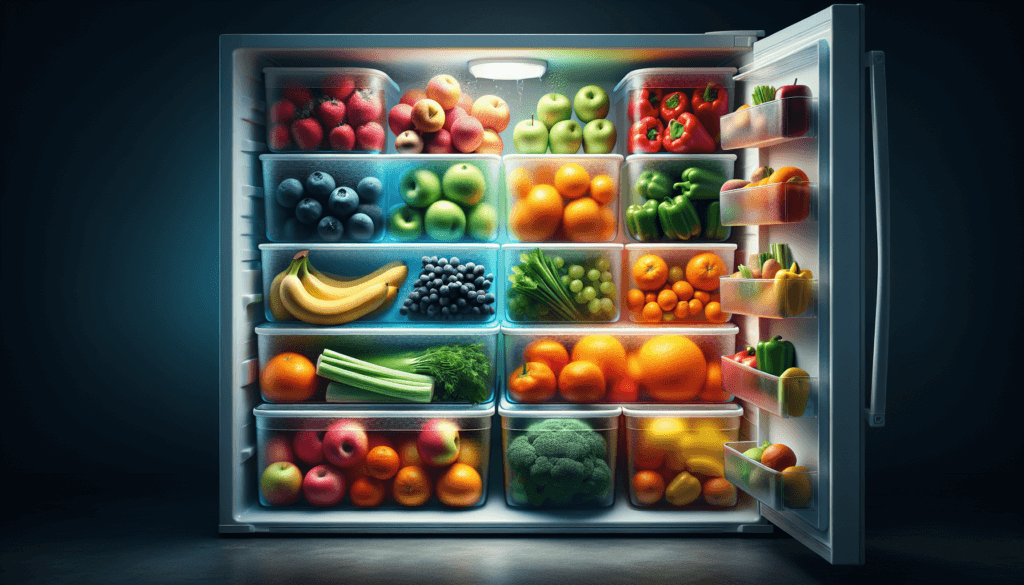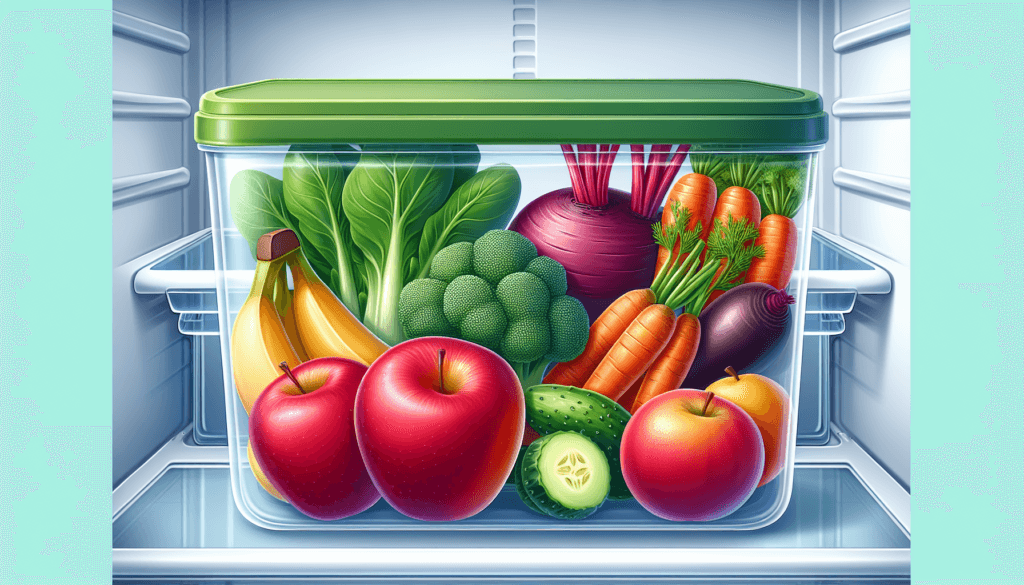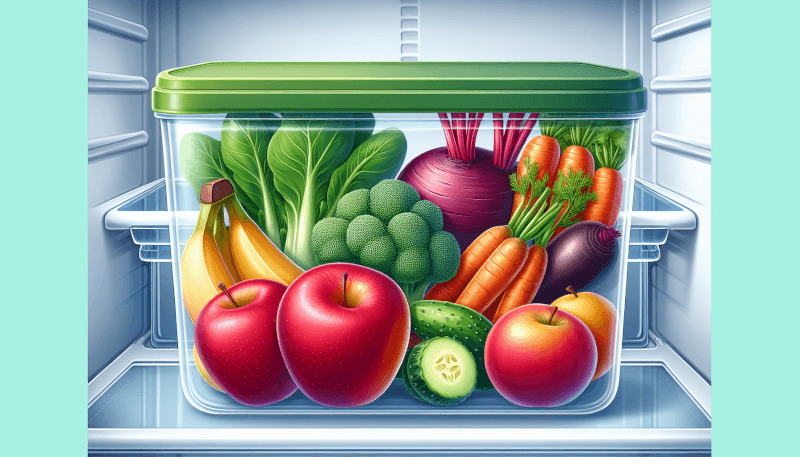Have you ever found yourself frustrated with how quickly your fresh produce goes bad? We all know the disappointment of purchasing that perfect avocado or ripe bunch of bananas, only to have them turn brown and mushy within days. But fear not! In this article, you will discover the best ways to make your produce last longer. Whether you’re looking to extend the lifespan of your leafy greens, crisp up your cucumbers, or keep those berries fresh and juicy, we’ve got you covered. Say goodbye to food waste and hello to longer-lasting, vibrant produce that will make your taste buds sing. Let’s get started!

Proper Storage
Proper storage is key to keeping your produce fresh and extending its lifespan. By following these storage tips, you can ensure that your fruits and vegetables stay fresh and delicious for a longer time.
Store in the refrigerator
The refrigerator is an excellent place to store most types of produce. The cool temperature helps slow down the ripening process and prevents spoilage. However, not all fruits and vegetables should be stored in the fridge.
Separate ethylene-producing fruits
Some fruits, like apples, bananas, and avocados, produce a natural gas called ethylene, which speeds up the ripening process. It’s important to separate these ethylene-producing fruits from other produce to prevent premature ripening and spoilage.
Keep potatoes in a cool, dark place
Potatoes should be stored in a cool, dark place, such as a pantry or cellar. Exposure to light can cause potatoes to sprout, while heat can lead to quicker spoilage. To keep them fresh, store potatoes in a breathable bag or a paper bag to allow air circulation.
Use breathable containers
Using breathable containers, such as mesh bags or perforated plastic bags, is essential in prolonging the shelf life of your produce. These containers allow for proper air circulation, preventing moisture build-up and reducing the risk of mold growth.
Preparation Techniques
Properly preparing your produce before storing it can significantly impact its freshness and longevity. Here are a few techniques to ensure your fruits and vegetables stay fresh for as long as possible.
Wash and dry before storage
Before storing your produce, make sure to wash it thoroughly to remove any dirt, bacteria, or pesticides. After washing, allow your fruits and vegetables to dry completely before storage. Moisture can speed up decay and spoilage, so it’s important to ensure they are dry before putting them away.
Trim and remove damaged parts
Inspect your produce for any signs of damage or rotting. Trim off any bruised or browned areas to prevent the spread of decay and prolong the freshness of the remaining parts. Removing damaged parts can also help maintain the flavor and quality of your fruits and vegetables.
Prevent browning with acidic solutions
Certain fruits, like apples and avocados, are prone to browning when exposed to air. To prevent this, you can use acidic solutions like lemon juice or vinegar. Simply dip your sliced fruits or vegetables in the solution for a few seconds, then drain and store them. The acidity acts as a natural preservative and helps delay browning.
Blanch and freeze for long-term storage
If you have an abundance of produce that you can’t consume before it spoils, consider blanching and freezing them for long-term storage. Blanching involves briefly immersing fruits or vegetables in boiling water, then quickly cooling them in ice water. This process helps preserve the color, texture, and nutrients of the produce, allowing you to enjoy it for months to come.

Handling and Buying Tips
Proper handling and buying practices are essential to ensure you bring home the freshest produce and maintain its quality throughout its lifespan. Follow these tips to make the most of your grocery shopping experience and keep your produce in top shape.
Inspect before buying
Before adding any fruits or vegetables to your cart, take a moment to inspect them. Look for signs of freshness, such as vibrant colors, firm texture, and no signs of wilting or mold. Avoid purchasing produce that is bruised, damaged, or overripe, as these are more likely to spoil quickly.
Avoid bruising
Handle your produce with care to avoid bruising, as even minor bruises can accelerate decay and spoilage. When selecting fruits and vegetables, gently place them in your basket or bag, avoiding rough handling or placing heavy items on top of delicate produce. If possible, choose produce that is undamaged and still attached to its stem or leaves.
Handle with care
When you bring your produce home, continue to handle it with care. Avoid dropping or banging it against hard surfaces, as this can cause bruising and damage. Treat your fruits and vegetables delicately to ensure they stay fresh and retain their nutritional value.
Only buy what you need
To prevent unnecessary waste, only buy the amount of produce that you will reasonably consume within a specific timeframe. While it can be tempting to stock up on fruits and vegetables, purchasing too much can lead to spoilage and food waste. Plan your meals accordingly and buy smaller quantities more often to maximize freshness.
Produce-Specific Tips
Different types of produce have unique storage and handling requirements. Here are some specific tips to help you keep common fruits and vegetables fresh for longer.
Berries: Rinse with vinegar-water solution
Berries, such as strawberries, raspberries, and blueberries, are delicate and prone to mold. To extend their shelf life, rinse them with a solution of vinegar and water. Mix one part vinegar with three parts water, gently swish the berries in the solution, rinse thoroughly, and pat them dry before storing.
Leafy Greens: Store with a damp paper towel
To keep leafy greens like lettuce, spinach, and kale crisp and fresh, wrap them in a damp paper towel before placing them in a breathable bag or container. The moisture from the paper towel helps prevent wilting and keeps the greens hydrated.
Tomatoes: Store stem-side down
Tomatoes should be stored with their stems facing downward. Storing them upside down helps prevent air and moisture from entering the stem area, reducing the chances of spoilage. If you have ripe tomatoes that need to last a bit longer, it’s best to store them in the fridge.
Citrus Fruits: Keep in a cool, dry place
Citrus fruits, such as oranges, lemons, and grapefruits, should be stored in a cool, dry place outside of the refrigerator. Room temperature is ideal for these fruits, as prolonged exposure to cold temperatures can negatively affect their flavor and texture.

Proper Ripening
Controlling the ripening process of your fruits and vegetables is crucial to maximize their freshness and flavor. By following these tips, you can ensure that your produce ripens at the right pace and stays fresh for longer.
Control ripening with temperature and humidity
Different fruits and vegetables have varying temperature and humidity requirements for optimal ripening. Some fruits, like bananas and avocados, benefit from being stored at room temperature to ripen gradually. On the other hand, some fruits, like peaches and melons, can be left out for a day or two to ripen and then refrigerated to slow down further ripening.
Separate ripening fruits from others
To prevent premature ripening, it’s essential to separate fruits that are already ripening from those that are still unripe. Ripe fruits produce ethylene gas, which can accelerate the ripening process of nearby produce. By separating ripening fruits, you can control their ripening pace and prolong the freshness of your other fruits and vegetables.
Preservation Methods
If you find yourself with excess produce on hand, or you simply want to extend the shelf life of your favorite fruits and vegetables, consider these preservation methods. These techniques allow you to enjoy fresh produce even when it’s out of season.
Canning
Canning is a popular preservation method that involves sealing fruits and vegetables in jars with airtight lids. The produce is typically cooked or processed before canning to kill bacteria and ensure safety. Canned fruits and vegetables can be stored for months or even years, making them a great way to enjoy your favorite produce long after harvest.
Dehydrating
Dehydrating removes the moisture from fruits and vegetables, preventing spoilage and extending their shelf life. You can dehydrate produce by using an oven, food dehydrator, or even by air-drying in a sunny location. Dehydrated fruits and vegetables can be stored in airtight containers for months and are excellent for snacking or adding to recipes.
Freezing
Freezing is a simple and effective way to preserve the freshness of your produce. Most fruits and vegetables can be blanched, cooled, and frozen for long-term storage. Freezing helps maintain the flavor, texture, and nutritional value of the produce, allowing you to enjoy it at a later time.
Pickling
Pickling is a method that involves immersing fruits and vegetables in a solution of vinegar, water, and spices. The acidity of the pickling mixture helps preserve the produce and gives them a unique flavor. Pickled fruits and vegetables can be stored in jars in the refrigerator for several weeks, providing a tangy and delicious addition to your meals.
Fermenting
Fermentation is a preservation technique that uses bacteria and yeasts to break down sugars in fruits and vegetables, creating lactic acid and preserving the produce. Fermented fruits and vegetables, such as sauerkraut and kimchi, have an extended shelf life and offer numerous health benefits. Proper fermentation requires careful temperature and storage conditions to ensure food safety.

Produce Storage Mistakes to Avoid
Even with the best intentions, it’s easy to make storage mistakes that can shorten the shelf life of your produce. By avoiding these common pitfalls, you can ensure your fruits and vegetables stay fresh and delicious.
Storing in plastic bags
While plastic bags are convenient for carrying produce, storing fruits and vegetables in them can trap moisture and promote mold growth. Instead, opt for breathable containers or bags that allow air circulation and prevent moisture build-up.
Refrigerating certain fruits and vegetables
Not all fruits and vegetables benefit from refrigeration. Some produce, like tomatoes, bananas, and potatoes, can lose flavor and texture when stored in the fridge. It’s important to research the specific storage requirements of each fruit and vegetable to determine whether refrigeration is necessary.
Keeping produce near heat sources
Exposing fruits and vegetables to heat sources, such as stoves or direct sunlight, can accelerate the ripening process and lead to spoilage. Keep your produce away from heat sources to maintain its quality and freshness.
Storing bruised or damaged produce
Bruised or damaged produce is more susceptible to spoilage and can quickly spread decay to other fruits and vegetables. It’s best to consume or discard bruised produce promptly to avoid compromising the quality of the rest of your fresh produce.
Using Freshness Tricks
If your produce is starting to wilt or show signs of mold, there are a few tricks you can try to revive or salvage it. These freshness tricks can help extend the lifespan of your fruits and vegetables and reduce food waste.
Revive wilted produce with cold water
If your leafy greens or other produce is starting to wilt, you can revive them by soaking them in cold water for a few minutes. This rehydrates the produce and helps regain its crispness and freshness.
Eliminate mold with vinegar
If you spot mold on your fruits or veggies, you can remove it by rinsing them with a solution of vinegar and water. Mix one part vinegar with three parts water, gently scrub the affected areas, rinse thoroughly, and pat them dry. This method can help salvage produce that is still fresh and edible.
Extend lifespan with breathable bags
Using breathable bags or containers can help extend the lifespan of your produce. These bags allow proper air circulation, reducing moisture build-up and preventing mold growth. Store your fruits and vegetables in these breathable bags to maintain their freshness and quality for longer periods.

Garden-to-Table Tips
If you have a home garden or access to fresh produce straight from the farm, these tips can help you make the most of your harvest and enjoy your fruits and vegetables at their peak.
Harvest at peak ripeness
To enjoy the best flavor and nutritional value, harvest your fruits and vegetables at their peak ripeness. Each type of produce has different signs of ripeness, such as color, texture, or ease of picking. Harvesting at the right time ensures maximum flavor and quality.
Clean and store properly
After harvesting your produce, it’s essential to clean it thoroughly to remove any dirt or pests. Gently wash each item under running water, brushing off any debris. Once clean, dry the produce completely before storing it to prevent moisture-related issues.
Grow and pick in stages
To prolong your homegrown produce’s availability, consider planting fruits and vegetables in multiple stages. This staggered approach to planting ensures a continuous supply of fresh produce throughout the season, rather than having everything ripen at once.
Preserve excess produce
If you find yourself with excess homegrown produce, don’t let it go to waste. Consider preserving it through canning, freezing, or other methods mentioned earlier. This way, you can enjoy the fruits of your labor long after the growing season is over.
Produce Shelf Life Resources
If you ever find yourself unsure of how long a specific fruit or vegetable can be stored, several resources can help you determine its shelf life and optimal storage conditions.
Online shelf-life guide
Numerous websites provide detailed information on the shelf life of various fruits and vegetables. These guides outline the expected lifespan of each produce item and offer tips on storage, ripening, and preventing spoilage.
Produce storage infographic
Infographics are a visual tool that consolidates information into a concise and easy-to-understand format. Look for produce storage infographics that provide key details on how to store different fruits and vegetables for optimal freshness.
Mobile applications
Various mobile applications are designed to assist with produce storage and preservation. These apps often include features like personalized storage recommendations, expiration tracking, and recipes to help you make the most of your fresh produce.
By following these tips and tricks, you can make the most of your produce, minimize waste, and enjoy fresh and flavorful fruits and vegetables for an extended period. Proper storage, handling, and preservation techniques are essential in maintaining the quality of your produce, maximizing its lifespan, and reducing food waste. With a little care and attention, you can make your produce last longer and enjoy its optimal flavor and nutrition. So, start implementing these practices today and savor the taste of your fresh produce!


